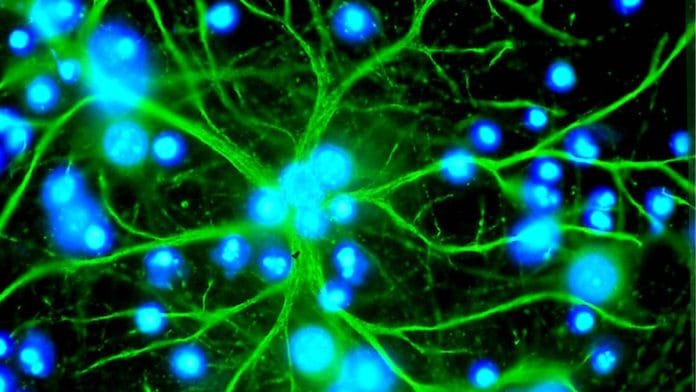New Delhi: For a long time, astrocytes, the star-shaped cells in the nervous system, were considered the “wallflowers” of neuroscience, with their role relegated to only supporting and protecting neurons. However, that view has been changing.
Three new studies in Science, a journal by the American Association for the Advancement of Science, have shown that astrocytes are at the frontier of how our brain sends signals and alters body functions—a finding that an increasing body of work has been backing up.
In step with the finding, the May issue of Science rechristened the astrocytes this year as the “hidden puppet masters of the brain”.
Neurons have, traditionally, been credited for transmitting signals and enabling complex communication, whereas in the background, astrocytes, which are non-neuronal or glial cells, ensured their seamless function.
However, a study on mouse models has shown that the brain chemical associated with alertness, attention, and learning affects mice functions by acting directly on their astrocytes, not neurons. Another study has uncovered how astrocytes are “orchestrating a complex network, governing brain function” in fruit flies. The third study builds on a previous 2019 research on how astrocytes triggers neuron activity and causes zebra fish to stop swimming.
“Disorders, such as depression, anxiety, and schizophrenia, which are traditionally attributed to neuronal neuro-modulatory receptor dysfunction, may stem from disrupted astrocyte signalling,” Cagla Eroglu, a neuroscientist and associate professor at Duke University, wrote in a Science article, explaining the significance of the three studies. “Exploring the potential clinical applications of astrocyte-targeted interventions may unveil new therapeutic avenues for these disorders.”
Also Read: India’s top students wanted to be doctors. Not anymore
Chemical messengers of the brain
Neuromodulators and neurotransmitters are two different kinds of chemical messengers in our nervous system. Neurotransmitters carry a specific message to our nerve cells, affecting our mood, movement, or sensation.
Neuromodulators include dopamine, which guides the reward system in the brain, and norepinephrine, which generates fight or flight responses. However, norepinephrine has neurotransmitter functions too.
Both neuromodulators and neurotransmitters will affect the transmission of signals between neurons to do what they are required to do.
Both are like tiny messengers, finding their way inside the brain, binding to receptors on the neurons to modulate or strengthen communication between them. The feat is not easy, but astrocytes make it happen.
Astrocytes, the three independent studies have shown, are indispensable to neuro-modulatory signalling. They play a vital role in how the brain processes information and maintains balance.
“I think the prevailing view is that a lot of the computations that are important for behaviour come out of the patterns of connectivity between neurons,” Alex Chen, a joint PhD student in the Ahrens Lab at Janelia, said in a press release.
In 2019, Janelia researchers uncovered the role of astrocytes in the “giving up” behaviour of a zebrafish. According to the press release, they found that astrocytes act as a counter, telling the fish to stop swimming when it is not getting anywhere.
The scientists did not know how the astrocyte-neuron communication happened.
They, however, knew that without astrocytes, neurons could not function. Astrocytes provide structural support and maintain an environment for steady communication between neurons, besides helping to remove excess neurotransmitters and preventing our brain from overstimulation.
“This work shows that we have to understand biochemical computations and other forms of non-neuronal information and combine them with information about the connections between neurons to, really, understand what the brain is doing,” Chen added.
In the second study, scientists at Oregon Health & Science University (OHSU) provided direct evidence of real-time astrocyte action in the live brains of fruit flies. The scientists replicated the discovery in the astrocytes of rodents. According to a media release, the experiments suggested astrocyte action is an ancient feature of evolution, likely conserved in other mammals, including humans.
“I think it’s evolutionarily relevant to survival,” said lead author Kevin Guttenplan, PhD and a postdoctoral scientist at OHSU.
Similarly, the researchers at Washington University School of Medicine in St. Louis detected the role of astrocytes during states of heightened vigilance or attention in mice.
“Textbooks tell us that everything in the brain is about neurons,” said Thomas Papouin, PhD and an assistant professor of neuroscience at WashU Medicine. “It seems that a lot of brain wiring and activity is probably orchestrated by astrocytes, on slower timescales. This is the type of discovery that profoundly reshapes our understanding of how the brain works.”
What the findings mean for humans
Astrocytes play a role in neurological diseases, such as amyotrophic lateral sclerosis (ALS), as well as Parkinson’s and Huntington’s diseases. These debilitating diseases occur due to the loss of cells in the central nervous system. Alzheimer’s, on the other hand, occurs due to cell loss in the memory function area of the brain.
A common link in all these diseases is the loss of astrocytes.
In 2024, scientists from McGill University examined what happens when astrocytes are transplanted and integrated into the central nervous system. This area is under research for the possible treatment of Parkinson’s disease and other neurological diseases.
It marks a shift in the way neuroscientists are looking at astrocytes.
(Edited by Madhurita Goswami)






